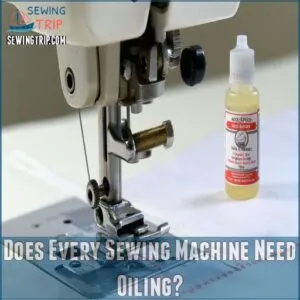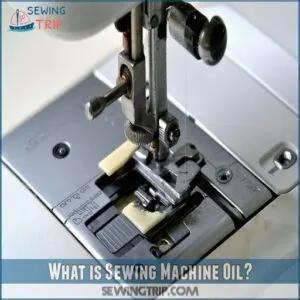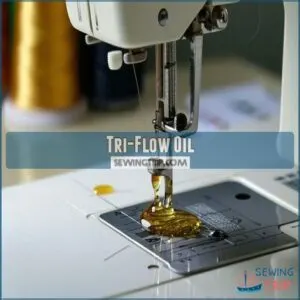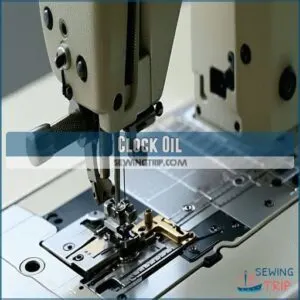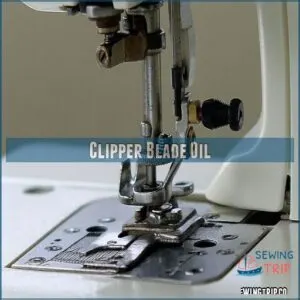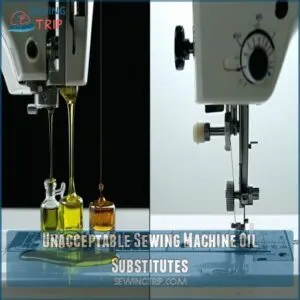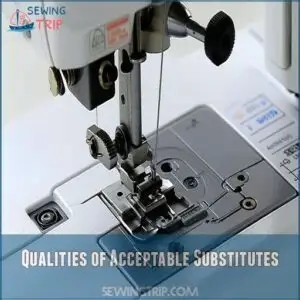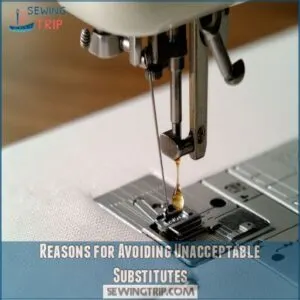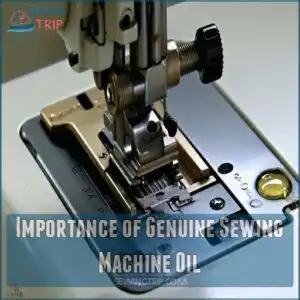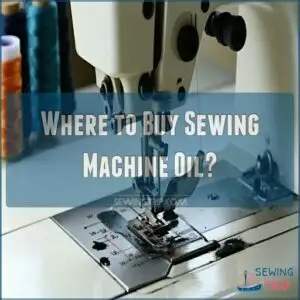This site is supported by our readers. We may earn a commission, at no cost to you, if you purchase through links.
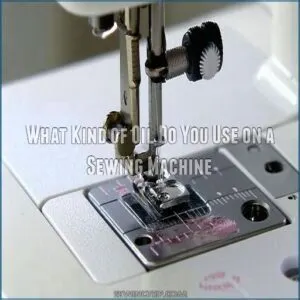 When considering what kind of oil to use on a sewing machine, go for specialized sewing machine oil; it’s like a spa treatment for your machine!
When considering what kind of oil to use on a sewing machine, go for specialized sewing machine oil; it’s like a spa treatment for your machine!
This clear, refined mineral oil won’t gum up the works like its household counterparts such as WD-40 or 3-in-1 oil.
If you’re in a bind, Tri-Flow oil or mineral oil might save the day, but steer clear of kitchen concoctions like olive oil—you won’t like the results.
Proper oil keeps your machine purring without hiccups, prolonging its lifespan. Curious about substitutes that won’t sabotage your sewing? Stay tuned for more safe options!
Table Of Contents
- Key Takeaways
- What Kind of Oil Do You Use on a Sewing Machine
- Does Every Sewing Machine Need Oiling?
- What is Sewing Machine Oil?
- Acceptable Sewing Machine Oil Substitutes
- Unacceptable Sewing Machine Oil Substitutes
- Qualities of Acceptable Substitutes
- Reasons for Avoiding Unacceptable Substitutes
- Importance of Genuine Sewing Machine Oil
- Where to Buy Sewing Machine Oil?
- How to Oil a Sewing Machine?
- Frequently Asked Questions (FAQs)
- Conclusion
Key Takeaways
- Always use specialized sewing machine oil to keep your machine running smoothly and avoid damage.
- If you are out of sewing machine oil, you can safely use Tri-Flow oil or mineral oil as alternatives.
- Avoid using household oils like WD-40, vegetable oil, or baby oil as they can cause buildup and damage.
- Regular oiling, particularly for older machines, helps prolong their lifespan and ensures optimal performance.
What Kind of Oil Do You Use on a Sewing Machine
Keeping your sewing machine running smoothly requires using the right oil, especially after you’ve learned the Sewing Machine Basics.
You’ll want to use specialized sewing machine oil – a highly refined, crystal-clear mineral oil designed specifically for your machine’s delicate parts. Think of it as premium fuel for your mechanical companion.
While it might be tempting to reach for that WD-40 or cooking oil sitting in your kitchen cabinet, these can be disastrous for your machine. Sewing machine oil is formulated to have just the right viscosity and purity to protect your machine’s components without leaving harmful residues.
Popular brands like Dritz, Singer, and Schmetz offer reliable options that won’t break the bank. Remember, investing in proper oil now can save you from costly repairs down the road.
Does Every Sewing Machine Need Oiling?
Every sewing machine has its own unique maintenance needs. Modern machines often feature self-lubricating parts, while vintage models need regular oiling to keep humming along.
If you’ve got a machine built before the 1950s, you’ll definitely need to make oiling part of your routine, and be sure to inspect for skipped stitches causes.
For newer machines, check your manual first – some are designed to be oil-free or only need lubrication in specific spots like the hook area. If your machine does need oiling, timing matters: lubricate after every 3-4 bobbin changes.
Think of car maintenance – regular oil changes keep everything running smoothly. Skip this step with an older machine, and you might hear some unhappy noises or face mechanical issues down the road.
What is Sewing Machine Oil?
The right oil is your sewing machine’s best friend – it keeps everything running smoothly while protecting important parts from wear and tear. Think of it as your machine’s daily vitamin, essential for long-term health and performance.
You can find various types of sewing machine oil for sale online, such as on websites offering sewing machine oil products, which is great for those looking for convenience.
Sewing machine oil comes in three main varieties: natural (plant-based), mineral (petroleum-derived), and synthetic (lab-created). While natural oils are eco-friendly, they don’t last as long as their counterparts. Mineral oil is the industry standard – it’s clear, odorless, and gentle on your machine. Synthetic oils pack extra punch, especially for machines with plastic components.
When picking your oil, consider its viscosity (thickness) – this affects how well it flows and lubricates.
Store it properly in a cool, dark place, and it’ll last about five years before needing replacement.
Acceptable Sewing Machine Oil Substitutes
When you’re out of sewing machine oil, you’ll be glad to know there are several reliable alternatives that won’t harm your machine.
You can safely use Tri-Flow oil, mineral oil, clock oil, or clipper blade oil as these substitutes share similar properties with regular sewing machine oil and won’t leave harmful residue.
Tri-Flow Oil
Looking for a reliable sewing machine oil alternative? Tri-Flow oil might be your new best friend. This premium lubricant contains Teflon.
- Deep penetration into tight spots where regular oils can’t reach
- Long-lasting protection against friction and wear
- Dust-resistant properties that keep your machine cleaner longer
Plus, it’s readily available and won’t break the bank, making it a smart choice for both beginners and pros.
Mineral Oil
You’ll be glad to know mineral oil ranks among the most reliable substitutes for sewing machine oil.
Made from refined petroleum, it offers the perfect viscosity your machine needs.
It’s both colorless and odorless, making it ideal for fabric work.
Plus, its light consistency helps protect metal parts while preventing rust.
Just remember to check your machine’s manual first – some manufacturers have specific recommendations.
Clock Oil
When your regular sewing machine oil runs dry, clock oil steps in as a reliable substitute.
Its refined petroleum formula provides smooth lubrication for your machine’s moving parts.
Its non-detergent properties make it safe for mechanical components, though you’ll want to account for the higher cost per bottle.
For best results, choose clock oil with light viscosity similar to standard sewing machine oil.
Clipper Blade Oil
Hidden in your toolbox, clipper blade oil stands as a reliable ally for your sewing machine’s health.
Like its cousin sewing machine oil, it’s mineral-based and perfectly matched to keep your machine purring.
A few strategic drops can prevent wear, extend part life, and maintain smooth operation. Focus on metal-to-metal contact points for best results – just don’t overdo it, as a little goes a long way. clipper blade oil and sewing machine oil.
Unacceptable Sewing Machine Oil Substitutes
While you might be tempted to grab whatever oil is handy in your garage or kitchen, using the wrong lubricant can seriously damage your sewing machine’s delicate parts.
You’ll want to avoid common household products like WD-40, cooking oils, or baby oil, which can leave sticky residue and potentially lead to costly repairs.
3. in-1 Multipurpose Lubricant
Let’s bust a common myth: 3-in-1 multipurpose lubricant isn’t your sewing machine’s friend.
While it might seem like a handy solution, this oil’s thick consistency and hidden additives can spell trouble.
Think of it like putting maple syrup in your car’s engine – it’ll gum up the works.
The detergents and heavy oils in 3-in-1 build up residue, leading to sticky mechanisms and potential damage.
WD-40
WD-40 might seem like a smart fix for your squeaky sewing machine, but it’s actually one of the worst choices you could make.
Despite its reputation as a universal lubricant, WD-40 leaves behind a sticky residue that can gum up your machine’s delicate parts.
It’ll eventually harden, potentially causing expensive damage to your machine’s mechanisms. Skip the WD-40 and stick to proper sewing machine oil instead.
Baby Oil
Baby oil might seem like a gentle choice for your sewing machine, but it’s actually one of the worst substitutes you could pick.
Despite its smooth texture, baby oil’s composition can seriously harm your machine’s delicate parts. The oil’s viscosity isn’t designed for mechanical use, leading to sticky residue buildup that can jam your machine’s mechanisms and even cause skin irritation during sewing.
| Unacceptable Substitute | Reason |
|---|---|
| Baby Oil | Its viscosity and composition aren’t suited for sewing machines. Can cause residue buildup and skin irritation. |
| WD-40 | Evaporates quickly, leaving harmful residue. |
| 3-in-1 Multipurpose Lubricant | Too thick for precision parts. |
| Olive Oil | Goes rancid, causing damage. |
Lamp Oil (Paraffin)
Paraffin lamp oil might seem like a handy substitute for sewing machine oil, but it’s a recipe for disaster. While baby oil posed its own risks, paraffin brings unique hazards to your machine’s delicate parts.
Consider using oil specifically designed for sewing machines, like those found at best sewing machine oil options online.
Here’s why you should skip the lamp oil:
- Creates sticky residue that attracts dust and lint
- Evaporates quickly, leaving gummy deposits
- Contains additives that can corrode metal parts
Olive Oil
While lamp oil’s no good for your machine, olive oil might seem like a natural choice since it’s readily available in your kitchen.
But here’s the deal: olive oil turns rancid over time, leaving behind a sticky residue that attracts lint and dust.
It’ll gum up your machine’s moving parts, potentially leading to costly repairs.
Plus, as it dries out, it can harden and damage internal components.
Qualities of Acceptable Substitutes
Precision meets practicality when choosing the right substitute for sewing machine oil. Just like finding the perfect thread match, selecting an appropriate oil alternative requires attention to detail. The best substitutes share essential qualities that protect your machine’s delicate parts while keeping it running smoothly.
Here’s what makes a substitute oil worthy of your machine:
- Low viscosity that allows smooth flow between moving parts
- Residue-free formula that won’t gum up mechanisms
- Cost-effective pricing comparable to standard machine oil
- Easy availability at local craft or hardware stores
Think of acceptable substitutes like understudies in a play – they’re capable stand-ins when the star can’t perform. Options like Tri-Flow, mineral oil, clock oil, and clipper blade oil fit the bill perfectly, offering reliable performance without compromising your machine’s longevity.
Reasons for Avoiding Unacceptable Substitutes
Using the wrong oil on your sewing machine can be like trying to run with gum on your shoes; it creates sticky residue and disrupts smooth operation.
Stick with recommended oils to avoid turning a minor maintenance task into a costly repair job.
Residue Build-Up
Keeping your sewing machine purring like a kitten means steering clear of oils that cause residue buildup.
Imagine the chaos of using everyday oils—they’re like dirt magnets.
To guarantee high-quality sewing output and maintain a reliable sewing machine, it’s also important to regularly clean and oil sewing machines.
Instead, stick with Tri-Flow Oil or Mineral Oil for smooth sailing. These oils leave no trace behind, unlike the sneaky ones (WD-40, olive or baby oil) that gum up your machine, hampering performance.
Mechanism Disruption
Choosing the right oil for your sewing machine is like finding the perfect pair of scissors.
With the wrong oil, you risk mechanism disruption due to poor lubrication.
Too thick or thin oil viscosity can lead to sluggish performance or frequent reapplication.
Avoid oils that leave sticky residues, causing moving parts to gum up, reducing efficiency, and increasing maintenance needs.
Costly Repairs Risk
Using the wrong sewing machine oil? That’s a recipe for disaster!
The right oil keeps things running smoothly.
The wrong oil? Expensive repairs.
Think of it like this: would you put motor oil in your salad? Sewing machine oil is specifically designed to protect your machine. Choose wisely and save money!
Potential Part Damage
Ignoring proper sewing machine lubrication might lead to damaging delicate parts.
Improper oil types can gunk up the works, like molasses in your gears, causing mechanisms to stick or fail. This could leave you facing repair costs that’ll make your wallet wince.
Regular cleaning methods and sticking with the right sewing machine oil type guarantee your machine runs like clockwork, minus the drama.
Importance of Genuine Sewing Machine Oil
Investing in genuine sewing machine oil is like paying for that sturdy umbrella—sure, you could get the cheap one, but you’ll regret it when you’re left soaked.
The best sewing machine oil extends your machine’s life, but it also protects against damage, keeping your sewing investments safe and sound.
It’s also essential to service your sewing machine regularly (https://sewingtrip.com/should-you-service-your-sewing-machine/), as this can help prevent costly repairs and guarantee your gadget runs like clockwork.
Genuine sewing machine lubricant offers reliability you can count on, unlike off-brand experiments that could void your warranty and create more issues.
So, take this expert advice: opt for high-quality sewing machine oil, and enjoy smooth, trouble-free stitching for years to come.
Where to Buy Sewing Machine Oil?
Finding the right sewing machine oil doesn’t have to be a wild goose chase. Here’s a quick guide to grab the best sewing machine lubricant:
- Online Retailers: Amazon is your digital bazaar, showcasing options from Dritz oil to TriFlow Oil. Enjoy quick door-to-door convenience.
- Local Stores: Check out JoAnn and Michaels, not just for their fabrics, but also for essential sewing machine oils.
- Sewing Shops: Explore specialty stores for expert advice and a curated selection of lubricants.
- Hardware Stores: Surprisingly, places like Home Depot sometimes stock quality sewing machine oil.
By mixing online and physical stores, you’re sure to find the best lubricant for your machine!
How to Oil a Sewing Machine?
Regarding oiling your sewing machine, think of it as a spa day for your trusty mechanical pal.
First, unplug and clean—wipe away lint and grime to prevent a sticky mess.
Next, oil sparingly: like seasoning a dish, a drop on each moving part from your manual is just right.
Testing and storing come last; run a scrap fabric through to catch any excess oil. Then, store your oil in a cool, dry place to keep it in top condition.
Remember, frequent oiling, like regular dentist visits, keeps things running smoothly. Use the best sewing machine oil brands and follow these tips for hassle-free sewing adventures.
Frequently Asked Questions (FAQs)
What kind of oil do sewing machines use?
Sewing machines hum happily with the right oil. Use high-quality sewing machine oil, or a close substitute like mineral oil. Avoid anything else—your machine will thank you!
What is a good substitute for sewing machine oil?
You can use Tri-Flow oil or mineral oil as a substitute for sewing machine oil.
They’re both petroleum-based, residue-free, and safe alternatives.
Avoid household oils like WD-40 or cooking oils to prevent damage.
Can you use natural oils on a sewing machine?
Natural oils like olive or coconut aren’t ideal for sewing machines. They can gum up and cause issues.
Mineral-based sewing machine oils are a better choice.
They’re made to protect your machine and keep it running smoothly.
How do I choose a sewing machine oil?
Imagine a smooth-running machine.
Choose sewing machine oil that’s mineral-based for lubrication, non-toxic, colorless, and odorless.
Consider synthetic oils for superior performance, but always check your manual for specific recommendations on acceptable alternatives.
Can you use synthetic oil on a sewing machine?
Synthetic oil is a viable option for sewing machines, providing excellent lubrication and adhering well to metal parts.
While generally more expensive, it can be a great choice if you’re seeking superior performance and longevity.
Can you use petroleum oil on a sewing machine?
Yes, you can! Petroleum-based oils like mineral oil work great. Just avoid anything too thick or with additives. Always check your machine’s manual for specific recommendations. Happy sewing!
What can be used as sewing machine oil?
For sewing machine oil, you can use refined mineral oil or Tri-Flow oil.
These options keep your machine running smoothly.
Don’t use substitutes like WD- Stick to these to avoid machine damage and costly repairs.
Can I use WD-40 instead of sewing machine oil?
Using WD-40 as sewing machine oil isn’t a good idea.
It lacks the necessary lubrication and protection, potentially leading to rust and damage.
Stick to proper sewing machine oils to keep your machine running smoothly and safely.
Can I use vegetable oil on my sewing machine?
Imagine using molasses to lube a bike.
Vegetable oil isn’t designed for sewing machines—stick to sewing machine oil or mineral oil.
Proper oil keeps things smooth, prevents rust, and avoids gunky build-up that slows everything down.
Can I use gun oil on my sewing machine?
You shouldn’t use gun oil on your sewing machine.
It’s not designed for the intricate parts and could cause damage.
Stick to sewing machine oil or approved alternatives like mineral oil for best results and long-term care.
Conclusion
Choosing the right oil for your sewing machine is like finding the secret to eternal happiness for your threads!
Always opt for specialized sewing machine oil to keep your machine running smoothly.
If you’re in a pinch, Tri-Flow or mineral oil can work, but avoid kitchen oils.
These choices prevent damage and costly repairs, saving you time and hassle.
Now that you’re in the loop about what kind of oil you use on a sewing machine, you’re all set to sew with confidence!

